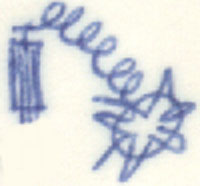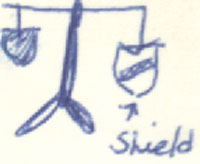
Words for Board: Feudalism, Lord, Vassal, Chivalry, Homage, Joust, Tournament, Moat

About 500 AD was the last stage of the dying Roman Empire. By about 800 - 814 AD, a barbarian king (Charles the Great, King of the Franks a.k.a. Charlemagne) ruled the Western Roman Empire. A series of Germanic tribes of barbarians had been attacking the Romans for years (Alaric I of the Visigoths sacked Rome in 410 AD, Attila of the Huns came later).
Germanic tribes (Huns, etc.) had been attacking the Roman Empire because they were under attack from the Vikings from the North countries (Sweden and Norway). The Vikings were hard to defend against cuz the National Army was in France. By the time the Army arrived, the Vikings had sacked the town. The people lost confidence in the National Government and quit paying taxes. Instead, they gave the money to the local militia (i.e. town goons) to protect them. It worked!! There weren't that many Vikings to begin with–they just appeared formidable cuz they used hit-and-run guerilla tactics on coastal towns. When the Vikings quit coming, the goons decided to take over the towns they were protecting (who said they were stupid?). The Vikings went on to capture Central Russia, found Iceland, etc. By 900 AD, the Vikings had stopped attacking the former Roman Empire, so the local goons took over the towns. These Viking raids had caused the breakdown of the central government. The town goons were tough and just took over their towns.
Feudalism was the military and political system of the Middle Ages. (I'd know that if I were you.) The goons decided that being bigger and tougher also must therefore make them noble (so, who's to argue?). You see, in the beginning, God made the King of France. (Where's France? You common peasant types ask. All around, of course. People's sense of geography was very limited plus France made up most of coastal Europe due to an early age monarch named Charlemagne–you may have heard of him–Gaul becomes Frankland which becomes France, essentially.) The army (town goons) is in control of the government. The goons become knights and begin to become orderly around 1000 AD.

Lord–someone noble–has somebody below him to give orders to and is supposed to be noble (usually by qualification that he's bigger than you are). A Vassal has somebody above him to take orders from (most of our ancestors were vassals!). Therefore, you can be a vassal and a lord at the same time, since the king is always above you. The Oath of Homage was an oral oath (since no one but monks can read or write). In it, the Lord promised the use of his land and the protection of his castle in case you are attacked. The vassals promised, in return, to fight for the lord and a percentage of things grown. The Vassal owed his lord 40 days of fighting per year. The system didn't work too well. Vassals could promise to fight for more than one lord which got to be sticky when both his masters were fighting amongst themselves. England's king, William the Conqueror, secured himself against this when he made the lords give him a direct oath.
The code of Chivalry was the etiquette and ideal for becoming a knight. You had to obey promises and oaths. You had to protect noble women and kids (non-noble women could fend for themselves). You must fight the enemies of the "true religion." (I.e. your religion–Catholicism).
Young nobles had to go through a training system. They were Pages (age 7-15) first. As a Page, you had to do odd jobs around the castle, learn songs, clean the rust off armor by putting it with sand in a barrel and rolling it around. At age 15, you could become a Squire (knight-in-training). You had to be able to use all of the equipment which was made out of bad iron. The defensive equipment consisted of: 1. Helmet–12-15 pounds of cast iron which tended to shift around on your head if not chained thereby causing the loss of your vision as you bounced around on your horse. 2. Chain mail–iron wires in circle links. It was good stuff for turning a sword cut but couldn't take a direct spear thrust.

3. Gloves with iron studs to turn sword blows. 4. Shield to take a direct blow with sword or lance. That's all for defense, folks. Offensive equipment (and it was offensive!) consisted of: 1. Lance–15-16 foot pole of ash tree with an iron point. It was to be carried under your arm and was sometimes counter-weighted. 2. Broad sword which had no edge but was wide and very heavy. 3. If you were the giant economy-size knight, you could wield an ax. 4. The true he-men used a mace and chain–a wooden ball with iron spikes in it–

(try not to get it wrapped around your neck). Hardly any knights were killed in battle. Of course, if you were wounded, your chance of living out the infection was slim. The object was to capture knights alive so you can sell them back to their friends. (Note: if one of your captured knights was wounded, and there are red streaks running from his gooey wound, you might want to lower his price).
When you could handle all these and had been tested, tried, and true, you got to advance to Knight, first class, at 21 years of age, if you had not been knighted before because of valor on the battlefield. As a knight, you were awarded your spurs (gosh). Before the ceremony, you had to pray all night in a church with your sword on the altar (point down) to form a cross, and (horrors) you had to bathe for spiritual purity symbolism. To prove yourself qualified, you showed your ability by jousting with a quintain (a telephone pole type of affair with a shield suspended and counterbalanced by a bag of rocks to upset you from your horse if you weren't quick enough).

Warfare was everything to the Middle Age people. Sometimes, peace accidentally broke out. Then you had a mock war called a Joust (between 2 knights) or a Tournament (between 2 teams of knights). But you used real weapons and the last man standing wins!! The weapons were so bad that Knight never died in battle. They may die later from blood poisoning due to rusty weapons but never in battle. During winter, when it's too cold to joust, they killed animals. At night, they played chess (mini-warfare on a board).
As a noble, you lived in a castle made of rocks from the good Roman road systems. The castle was protected by a Moat–an outer defensive ditch around the castle sometimes filled with water and slimy things. The moat was an idea stolen from the Romans. At first, castles were iron towers made of 15-foot thick walls. When the Vikings had time, they used to put a fire around the tower for roast noble–a delicacy of excellent taste! After the Vikings left, people expanded the castles. When attacked, what happens? (If you're asleep during this part of the lecture, wake up–it's probably Stockmyer at his best!) The attackers had to fill up the moat so they could get across. This took about 2 days. (Remember, this was pre-dump truck days.) In the meantime, the attackees were busy boiling oil, collecting the cattle and peasant dung and other ways of expressing their disapproval at being attacked. As an attacker, you could use a scaling ladder, but they were pushed off the wall. Since you couldn't get next to the castle, the counter-weighted catapult was invented. It was used to throws rocks at corners of the castle. People started building round castles (Rats!). Ok. Plan 47: put people next to the castle wall with a pick to get the mortar between the rocks so the castle would collapse and/or the attackers could run at the castle with a battering ram. So castle builders put iron doors on the walls that opened onto the inside. If your walls are being rammed, if your mortar is being picked, jump out your iron doors, get the enemy's part, and jump back in. Plan 52: As an attacker, you could build large towers as big as the castle walls but they tended to fall down. Or you could dig a tunnel to get under the castle wall. Now, if you are the attackee and it's awful quiet out there–then you hear the sound of large gophers, all you have to do is dig a counter tunnel that will connect to the side of their tunnel and flood it with water. Plan 73: Put your army around the perimeter of the castle to starve them out. Unfortunately, with the supply system as good as it is with armies, you will starve just as fast as the starvees. In other words, my fine feathered friends–castles didn't fall unless by treachery from the inside.